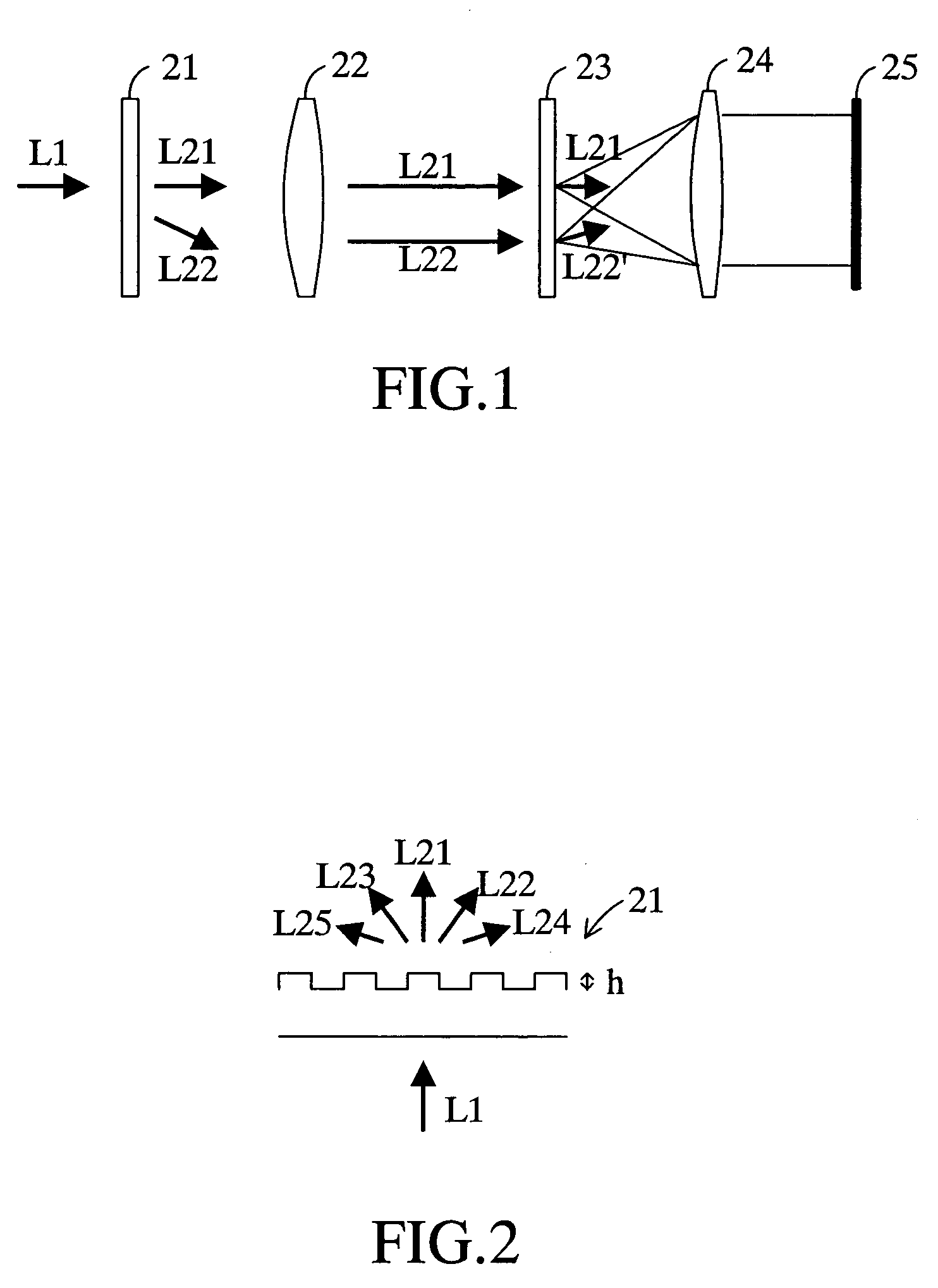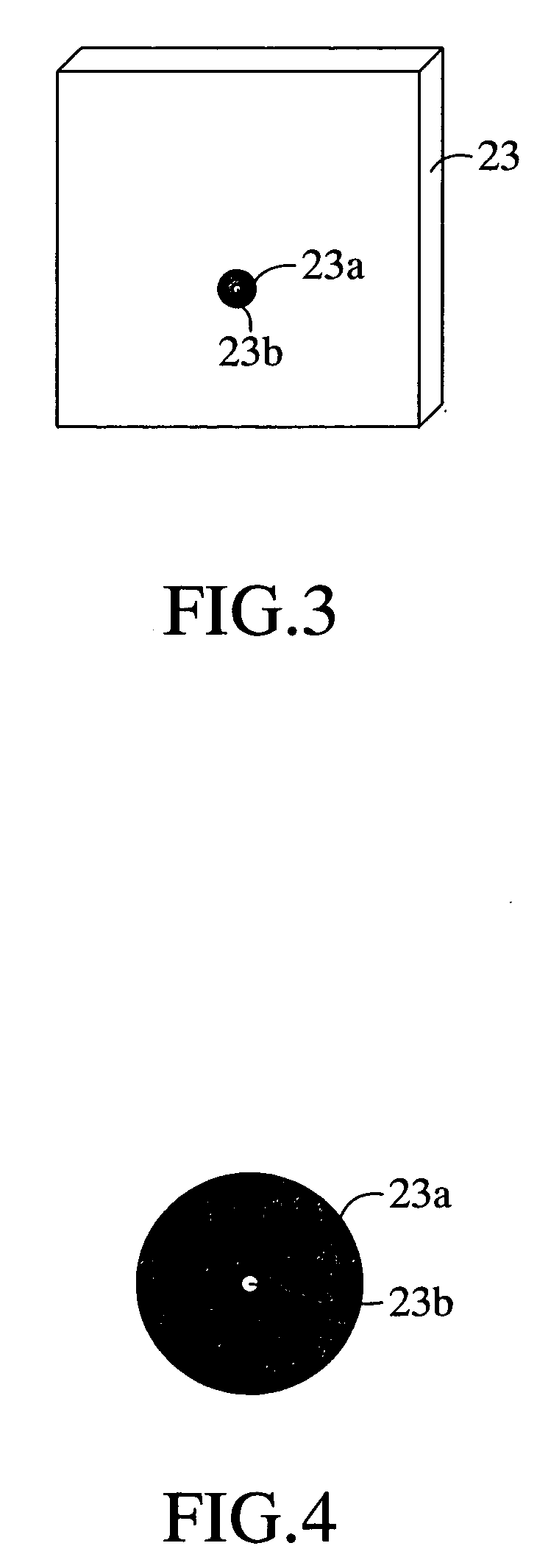Point diffraction interferometer with enhanced contrast
a point diffraction and contrast technology, applied in the field of interferometers, can solve the problems of deteriorating the accuracy of the wavefront measurement by this interferometer, and the inability to obtain sufficient contrast in the interference fringe, etc., and achieves the effects of improving the accuracy of the measurement of the wavefront, improving the accuracy of the measurement, and simple construction
- Summary
- Abstract
- Description
- Claims
- Application Information
AI Technical Summary
Benefits of technology
Problems solved by technology
Method used
Image
Examples
first embodiment
[0032]A first embodiment of the present invention will be explained herein below with reference to drawings. FIG. 1 schematically shows an interferometer according to the first embodiment for testing a performance of an incident beam L1. This interferometer has a diffraction grating 21 functioning as beam splitting means, a condenser lens 22 functioning as a first lens, a transparent substrate 23, a field lens 24 functioning as a second lens and an imaging device 25 arranged in this order.
[0033]The diffraction grating 21 has a cross section of a rectangular wave as shown in FIG. 2 that is a schematic sectional view. It produces a zeroth-order diffracted light L21, plus first-order diffracted light L22, minus first-order diffracted light L23, plus third-order diffracted light L24, minus third-order diffracted light L25 or the like with respect to the incident beam L1. It is to be noted that the diffracted lights used in this first embodiment are the zeroth-order diffracted light L21 ...
second embodiment
[0040]Subsequently, a second embodiment of the invention will be explained with reference to drawings. FIG. 5 schematically shows an interferometer according to the second embodiment for testing a performance of the incident beam L1. This interferometer is provided with a diffraction grating 31, beam splitter 32, mirror 33, lens 34 and imaging device 35.
[0041]The diffraction grating 31 has the same configuration as that of the diffraction grating 21 in the first embodiment and has the same function as that of the diffraction grating 21. It is to be noted that the diffracted lights used in this second embodiment too are the zeroth-order diffracted light L21 and the plus first-order diffracted light L22, so that the diffracted lights of the other order are unnecessary. Further, in this second embodiment too, only a part of the first-order diffracted light L22 reaches the imaging device 35 due to a transparent zone 33b of the mirror 33 described later, so that it is preferable to set t...
third embodiment
[0047]Subsequently, a third embodiment of the invention will be explained with reference to drawings. FIG. 8 schematically shows an interferometer according to the third embodiment. This interferometer utilizes a beam splitter 32A instead of the beam splitter 32. The beam splitter 32A transmits the zeroth-order diffracted light L21 and the plus first-order diffracted light L22 split by the diffraction grating 31 respectively to thereby allow these lights to reach the lens 34. And also, the beam splitter 32A reflects the zeroth-order diffracted light L21 and reference light L22′ propagated thereto from the lens 34 in the orthogonal direction to reach the imaging device 35. The other components are same as those in the second embodiment, so that they are given by the same numerals as in the second embodiment for omitting the explanation thereof.
[0048]In the third embodiment having the above-mentioned configuration too, the incident beam L1 that is a test subject is split into the zero...
PUM
 Login to View More
Login to View More Abstract
Description
Claims
Application Information
 Login to View More
Login to View More - R&D
- Intellectual Property
- Life Sciences
- Materials
- Tech Scout
- Unparalleled Data Quality
- Higher Quality Content
- 60% Fewer Hallucinations
Browse by: Latest US Patents, China's latest patents, Technical Efficacy Thesaurus, Application Domain, Technology Topic, Popular Technical Reports.
© 2025 PatSnap. All rights reserved.Legal|Privacy policy|Modern Slavery Act Transparency Statement|Sitemap|About US| Contact US: help@patsnap.com



